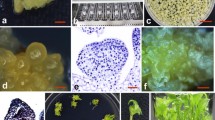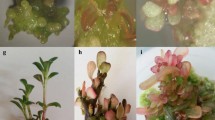Abstract
A method has been developed for embryogenic cell suspension cultures, plant regeneration and transformation of the important ornamental lily genotype (Lilium tenuifolium oriental × trumpet ‘Robina’). Bulb scales, filaments, ovaries and stem axis tissues were used as explants for callus induction in Murashige and Skoog (MS) medium with additions of growth regulators: picloram on its own, or in combination with 1-naphthaleneacetic acid (NAA), and thidiazuron (TDZ). The results show that the optimum medium for callus induction in bulb scale and filament tissue is MS + picloram 1.0 mg L−1, and for the ovary, it is MS + picloram 1.5 mg L−1. The stem axis had the highest rate (89.2 %) of callus induction with MS + NAA 2.2 mg L−1 + TDZ 0.1 mg L−1. The suspension cultures were established with the combination of NAA and TDZ with 2–5 mm cell clusters. These took a long time compared with suspension cultures established by picloram with 1–3 mm cell clusters. In three suspension cultures induced by picloram, the best callus from the point of view of proliferation and regeneration was derived from filaments. For plant regeneration, the growth rate of suspension cultures from the stem axis was higher than from the other three suspension culture induced by picloram. Vector pCAMBIA1301 with the β-glucuronidase (GUS) gene as reporter was transformed by Agrobacterium mediation into suspension cultures initiated from filament and stem axis material. After co-cultivation, the numbers of blue spots in material from the two sources were 26.8 ± 4.3 and 24.0 ± 4.7, respectively (difference not significant). Hygromycin-resistant callus was successfully regenerated into plantlets on plant growth regulator-free MS medium. Transgenic plants were also confirmed by the GUS histochemical assay, polymerase chain reaction.







Similar content being viewed by others
References
Azadi P, Chin DP, Kuroda K, Khan RS, Mii M (2010) Macro elements in inoculation and co-cultivation medium strongly affect the efficiency of Agrobacterium-mediated transformation in Lilium. Plant Cell Tissue Organ Cult 101:201–209
Boyde A, Wood C (1969) Preparation of animal tissues for surface-scanning electron microscopy. J Microsc 90:221–249
Chandler SF, Brugliera F (2011) Genetic modification in floriculture. Biotechnol Lett 33:207–214
Chong-Perez B, Reyes M, Rojas L, Ocana B, Perez B, Kosky RG, Angenon G (2012) Establishment of embryogenic cell suspension cultures and Agrobacterium-mediated transformation in banana cv. ‘Dwarf Cavendish’ (Musa AAA): effect of spermidine on transformation efficiency. Plant Cell Tissue Organ Cult 111:79–90
Cohen A (2011) Biotechnology in lilies—dreams vs. reality. Acta Hortic 900:149–160
Fereol L, Chovelon V, Causse S, Michaux-Ferriere N, Kahane R (2005) Establishment of embryogenic cell suspension cultures of garlic (Allium sativum L.), plant regeneration and biochemical analyses. Plant Cell Rep 24:319–325
Horita M, Morohashi H, Komai F (2002) Regeneration of flowering plants from difficile lily protoplasts by means of a nurse culture. Planta 215:880–884
Horita M, Moorhashi H, Komai F (2003) Production of fertile somatic hybrid plants between Oriental hybrid lily and Lilium × formolongi. Planta 217:597–601
Hoshi Y, Kondo M, Mori S, Adachi Y, Nakano M, Kobayashi H (2004) Production of transgenic lily plants by Agrobacterium-mediated transformation. Plant Cell Rep 6:359–364
Hoshi Y, Kondo M, Kobayashi H, Mori S, Nakano M (2005) Agrobacterium-mediated transformation of Lilium longiflorum. Acta Hortic 673:543–547
Jefferson RA, Kavanagh TA, Bevan MW (1987) GUS fusions: β-glucuronidase as a sensitive and versatile gene fusion marker in higher plants. EMBO J 6:3901–3907
Jeknic Z, Lee SP, Davies J, Ernst RC, Chen TH (1999) Genetic transformation of Iris germanica mediated by Agrobacterium tumefaciens. J Am Soc Hortic Sci 124:575–580
Katsumoto Y, Fukuchi-Mizutani M, Fukui Y, Brugliera F, Holton TA, Karan M, Nakamura N, Yonekura-Sakakibara K, Togami J, Pigeaire A (2007) Engineering of the rose flavonoid biosynthetic pathway successfully generated blue-hued flowers accumulating delphinidin. Plant Cell Physiol 48:1589–1600
Komai F, Morohashi H, Horita M (2006) Application of nurse culture for plant regeneration from protoplasts of Lilium japonicum Thunb. In Vitro Cell Dev Biol Plant 42:252–255
Liu J, Zhang J, Xu B, Jia C, Zhang J, Tan G, Jin Z (2011) Regeneration and production of transgenic Lilium longiflorum via Agrobacterium tumefaciens. In Vitro Cell Dev Plant 47:348–356
Mercuri A, Benedetti LD, Bruna S, Bregliano R, Bianchini C, Foglia G, Schiva T (2003) Agrobacterium-mediated transformation with rol genes of Lilium longiflorum Thunb. Acta Hortic 612:129–136
Mii M, Yuzawa Y, Suetomi H, Motegi T, Godo T (1994) Fertile plant regeneration from protoplasts of a seed propagated cultivar of Lilium × formolongi by utilizing meristematic nodular cell clumps. Plant Sci 100:221–226
Mori S, Adachi Y, Horimoto S, Suzuki S, Nakano M (2005) Callus formation and plant regeneration in various Lilium species and cultivars. In Vitro Cell Dev Plant 41:783–788
Murashige T, Skoog F (1962) A revised medium for rapid growth and bio assays with tobacco tissue cultures. Physiol Plant 15:473–497
Murray MG, Thompson WF (1980) Rapid isolation of high molecular weight DNA. Nucleic Acids Res 8:4321–4325
Nakano M, Sakakibara T, Suzuki S, Saito H (2000) Decrease in the regeneration potential of long-term cell suspension cultures of Lilium formosanum Wallace and its restoration by the auxin transport inhibitor, 2,3,5-triiodobenzoic acid. Plant Sci 158:129–137
Ndimba BK, Chivasa S, Hamilton JM, Simon WJ, Slabas AR (2003) Proteomic analysis of changes in the extracellular matrix of Arabidopsis cell suspension cultures induced by fungal elicitors. Proteomics 3:1047–1059
Nhut DT, Le BV, Minh NT, Teixeira SJ, Fukai S, Tanaka M, Van Tran Thanh K (2002) Somatic embryogenesis through pseudo-bulblet transverse thin cell layer of Lilium longiflorum. Plant Growth Regul 37:193–198
Ogaki M, Furuichi Y, Kuroda K, Chin DP, Ogawa Y, Mii M (2008) Importance of co-cultivation medium pH for successful Agrobacterium-mediated transformation of Lilium × formolongi. Plant Cell Rep 27:699–705
Ozawa K, Takaiwa F (2010) Highly efficient Agrobacterium-mediated transformation of suspension-cultured cell clusters of rice (Oryza sativa L.). Plant Sci 179:333–337
Polito VS, McGranahan G, Pinney K, Leslie C (1989) Origin of somatic embryos from repetitively embryogenic cultures of walnut (Juglans regia L.): implications for Agrobacterium-mediated transformation. Plant Cell Rep 8:219–221
Santos-Ballardo DU, Germán-Báez LJ, Cruz-Mendívil A, Fuentes-Gutiérrez CI, Milán-Carrillo J, Reyes-Moreno C, Valdez-Ortiz A (2013) Expression of the acidic-subunit of amarantin, carrying the antihypertensive biopeptides VY, in cell suspension cultures of Nicotiana tabacum NT1. Plant Cell Tissue Organ Cult 113:315–322
Sharma A, Mahinghara BK, Singh AK, Kulshrestha S, Raikhy G, Singh L, Verma N, Hallan V, Ram R, Zaidi AA (2005) Identification, detection and frequency of lily viruses in Northern India. Sci Hortic 106:213–227
Shoemaker RC, Couche LJ, Galbraith DW (1986) Characterization of somatic embryogenesis and plant regeneration in cotton (Gossypiurn hirsuturn L.). Plant Cell Rep 3:178–181
Stomp AM (1992) Histochemical localization of β-glucuronidase. In: Gallagher SR (ed) GUS protocols: using the GUS gene as a reporter of gene expression. Academic Press, San Diego, pp 103–113
Tanaka Y, Ohmiya A (2008) Seeing is believing: engineering anthocyanin and carotenoid biosynthetic pathways. Curr Opin Biotechnol 19:190–197
Tribulato A, Remotti PC, Löffler HJM, van Tuyl JM (1997) Somatic embryogenesis and plant regeneration in Lilium longiflorum Thumb. Plant Cell Rep 17:113–118
Wang Y, Kronenburg B, Menzel T, Maliepaard C, Shen X, Krens F (2012) Regeneration and Agrobacterium-mediated transformation of multiple lily cultivars. Plant Cell Tissue Organ Cult 111:113–122
Zhang P, Liu Y, Qi Y, Hua ZH (2010) Selection of Lily transformation varieties with the blue genes and a study of genetic transformation. [M. D. Dissertation]. Chin Agric Sci Bull 26:52–56
Acknowledgments
We would like to thank Dr Alexander (Sandy) Lang in New Zealand for professional editing services of the manuscript. This work was supported by the National High Technology Research and Development Program of China (863 Program) (Grant No. 2007AA10Z182).
Author information
Authors and Affiliations
Corresponding author
Additional information
Communicated by B. Borkowska.
Y. Qi and L. Du have contributed equally to this work.
Rights and permissions
About this article
Cite this article
Qi, Y., Du, L., Quan, Y. et al. Agrobacterium-mediated transformation of embryogenic cell suspension cultures and plant regeneration in Lilium tenuifolium oriental × trumpet ‘Robina’. Acta Physiol Plant 36, 2047–2057 (2014). https://doi.org/10.1007/s11738-014-1582-0
Received:
Revised:
Accepted:
Published:
Issue Date:
DOI: https://doi.org/10.1007/s11738-014-1582-0




